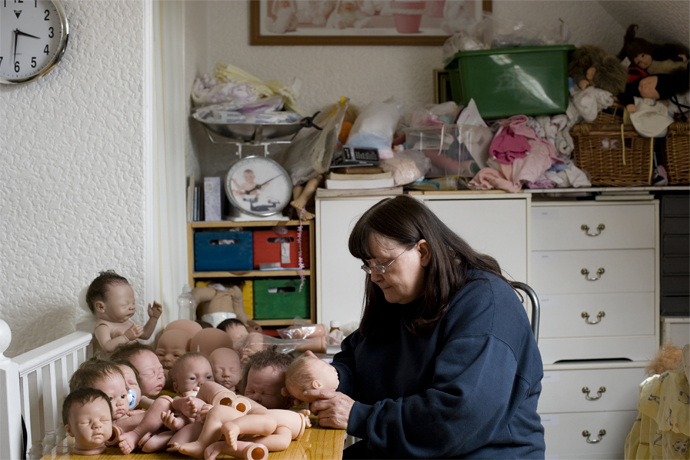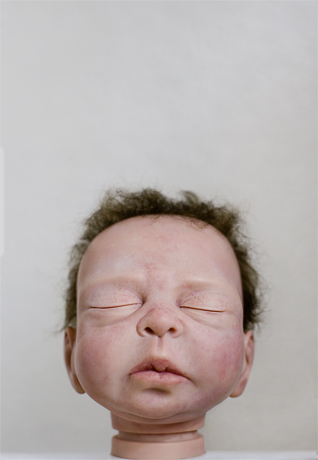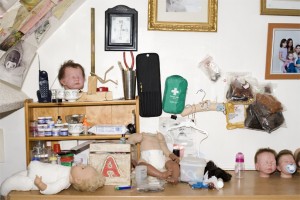Features
THE HOUSE OF DOLLS

“Weird. Freaky. Scary… Freaky and scary are the two you’d get most often. People tend to either like the dolls or hate them. There’s no in-between.” ‘Reborning’ is a bizarre craze that originated in America and now boasts a small but growing number of enthusiasts in Britain, Australia, New Zealand and Ireland. Though its precise origins are obscure, it is believed to have evolved in the late Eighties or early Nineties from more conventional forms of doll collecting. It was only with the advent of the internet, and (in particular) eBay, the it began to gain significant momentum. At its core are a small number of devotees who go to incredible lengths to create customised baby dolls that appear as lifelike as possible.
Recent years have seen a mini-industry of reborning manufacturers and collectors spring up online. Tynemouth railway station in Newcastle-upon-Tyne, however, is one of the few offline locations where members of the public might unexpectedly stumble upon these bizarre creations. At her stall in the station’s bustling flea market then, (self-proclaimed) ‘Reborn artiste’ Rosie Scott is in a unique position to witness people’s reaction to her work at first hand.
Their sometimes negative comments, though, don’t seem to bother her particularly. “People say they’re freaky. I just say ‘You mustn’t got any mirrors in your house then, pet!’ They say they’re scary, and I say ‘Not until they start climbin’ out of their cots – then I’m away!’ You break the ice that way. No matter what they say, I compensate with laughter and I never retaliate. Ever.”
1.
 Rosie Scott founded the Angelwing Nursery with her partner Kevan in 2002. She was inspired, she says, by a vision that appeared to her at a spiritual retreat. (“The spirit showed me baby booties. At first I thought ‘What thee hell are they giving us this for?’ I knew they weren’t mine cos I’d already had my babies.”) Working out of the attic in their modest council house, Rosie and Kevan create their reborn dolls by removing the factory paint, re-treating the skin and then individually threading thousands of hairs through the doll’s scull to create authentic looking baby hair and eyebrows. The doll’s body is reconstructed out of specially made silicon-vinyl, so that it feels and weights just like a real infant. It’s an incredibly laborious process, and one that both insist can only be undertaken as a labour of love.
Rosie Scott founded the Angelwing Nursery with her partner Kevan in 2002. She was inspired, she says, by a vision that appeared to her at a spiritual retreat. (“The spirit showed me baby booties. At first I thought ‘What thee hell are they giving us this for?’ I knew they weren’t mine cos I’d already had my babies.”) Working out of the attic in their modest council house, Rosie and Kevan create their reborn dolls by removing the factory paint, re-treating the skin and then individually threading thousands of hairs through the doll’s scull to create authentic looking baby hair and eyebrows. The doll’s body is reconstructed out of specially made silicon-vinyl, so that it feels and weights just like a real infant. It’s an incredibly laborious process, and one that both insist can only be undertaken as a labour of love.
Running the business is a challenge for a couple with little formal education and no business training. The various materials required have to be imported from Germany, Spain and the United States. “It used to be very inefficient at the start,” Rosie admits. “I’d put in an order in Spain and it’d take weeks to arrive. I’d ring ‘em and they’d say ‘We have holiday, we have holiday.’ You ‘ave more bloomin’ holidays than the Queen, I’d say. I couldn’t run my business like that. But I’ve found my own couriers now. They’re very good. If I put in an order, it’s on my doorstep two days later.”
As well as the doll, Angelwing customers receive a Moses basket, nappies, a shawl, soft toy, a brush and comb set and a special birth certificate. Rosie calls the dolls ‘babies’ and her customers their ‘Mammies’. “We deliver our babies to their new Mammies in person,” she says. “They come in little boxes that say Our New Baby. The boxes are specially designed… so as not to have a lid.” She pauses significantly, and I gaze back blankly. Then she spells it out for me. “It’s so they don’t resemble a coffin.”
Christ.
2.
The extremely creepy (but hitherto un-referred-to) subtext in all of this is something I intend to raise with Rosie and Kevan at some point. But it wouldn’t upset me too much if we tiptoed around it for a little while longer yet. Kevan and Rosie, though, are not nearly so squeamish. Some of their Mammies are specialist doll collectors, Kevan tell me. But the collectors wouldn’t be their biggest customers at all, he hastens to add. He lists their biggest customers in his thick Geordie accent. “Grandmothers that never had grandbairns. Women that lost bairns. Couples that can’t have bairns… They might have a little nursery built, so the doll would be left on the bed… There’s one woman, Beth, who’s had something like nine miscarriages. She’s got one.”
At some point, I know, I’m going to have to raise the possibility with Rosie and Kevan that what they’re actually doing here is exploiting the misfortunes of vulnerable people for their own profit. And that, for the record, they would appear to be doing so in the most breathtakingly macabre manner imaginable. Rosie may have already latched on to this, because whenever the subject appears to be heading in that direction, she lobs another conversational hang grenade into the mix. “The Sun asked to interview us about dead babies,” she announces matter-of-factly. “I says no way. I says no reborn can ever replace a child. Everyone has to have a grieving period to deal with the loss of a beloved child”.
What kind of a gap does she advocate leaving? “After a year or so, yeah, we’re happy to make a reborn. But not from a photograph or nothing. We call it Empty Arms Syndrome.”
I try a different tack. Reborn dolls don’t come cheap. Rosie and Kevan’s retail for Stg. £130-£300 stg each. Elsewhere on the internet they sell for as much as US$2-3,000. Aren’t they concerned about profiting from tragedy, I ask? Rosie scoffs at the idea. “We’re lucky if we make fifteen to twenty seven pound on a doll. That’s not including labour. People think we make a fortune, but we don’t at all.” She proceeds to explain that Reborning is much more of a vocation than a lucrative commercial venture and that profit margins are very low. It’s a convincing case she makes – albeit one in which she depicts herself as a sort of New Age amalgam of Florence Nightingale and Geppetto.
She tells me that many of her Mammies suffer from blindness, Down Syndrome or diabetes. “I havenae got a single healthy mother. I’m always on the other end of the phone to them. They talk about their selves, their aches and pains.” She mentions one customer, Bernadette, who suffers from severe Dystonia. It makes her feet turn in and leaves her in terrible pain. She requires regular Botox injections but can’t always make her appointments at the hospital. “She came down with the baby and I looked at [the doll] and said ‘Ah God, what’s wrong with ya pet?’ [The doll] had no colour, absolutely zilch.” The doll, Rosie believes, had taken on Bernadette’s pain. When Bernadette’s real daughter held the doll, pain suddenly shot through her body in turn. “See that” Rosie told the girl. “That’s the pain your Mummy’s in every minute of the day.”
Rosie has told me that people either love or hate her dolls. But after three hours at her stall, by far the most common reaction I’ve noticed from people is morbid fascination. They stare at the dolls. But they’re very reluctant to touch them. Children especially. Rosie catches my eye and returns to one of her earlier themes. “Folks sometimes say stuff like ‘Ohh, they’re just like dead babies’. I say ‘No, these babies are very much alive, thank you. They’re just sleeping’.” She takes a drag on her rollie cigarette and, almost as an afterthought, adds:
“Dead babies look like they’re made of candle wax. I should know – I’ve buried three of mine.”
3.
Down the coast in Sunderland, Jackie and her friend Ronnie are enjoying a glass of cider in their local Weatherspoon’s pub. They’re newer to the Reborning scene than Rosie, and they’re also much more wary of speaking to the media. Newspapers have stitched Reborners up in the past they tell me. “Our friend Wendy had a really bad write-up in a magazine, didn’t she?” recalls Jackie. “She gave a story and they took it totally out of perspective. Said she finds it’s better to sell to women who’ve lost babies, cause that way she gets more money. Made out like she was doing it purely for the money, not for the art. What bollocks!”
“She was really devastated about it,” confirms Ronnie. “She never thought they’d tear her to shreds like they did. She just told it as it is. And that’s what I’m doing with you here Eoin, ‘cause I don’t know what type of things you’ll print.” In truth, even the most cutthroat tabloid hack would have trouble painting these two in a sinister light. After a short chat it becomes quite apparent that Jackie and Ronnie are from Reborning’s Make & Do wing, rather than its Twilight Zone.
“You just take pride in knowing that you’ve accomplished something,” says Jackie. “That applies to any art form, whether its sculpting, oils, pastels or whatever.” Ronnie concurs: “You start, basically with a blank slate and you work at it until it looks like as much like what you want it to.” Ronnie believes that Reborning phenomenon started out originally with a group of enthusiasts who created customised dolls. As years went by, they began attempting to make them more and more accurate in appearance and detail.
“It’s no different,” reckons Jackie “to a filmmaker wanting to make his film as realistic as possible.
In a way then, it could be argued, that there really isn’t that much difference between what Jackie and Ronnie do, and what those men who collect model aircraft from World War I do. Or what those guys who build functioning model railway networks in their garages do. Jackie likes the analogy. “Yeah, men just have a different perspective from women. Women tend to go for dolls, whereas men tend to go for vehicles and machines and things.”
“Exactly,” agrees Ronnie. “I know you were talking to Rosie yesterday. She tends to do babies as portrait babies for women who have lost them. That’s what she mainly focuses on. She feels that she’s helping them with their grief. But from my point of view I’m just a collector who enjoys displaying them in a room at home”.
So then, the girls probably don’t do that other crazy stuff like giving their dolls birth certs or any of that nonsense? “Well, you would do the birth certificate alright,” Jackie hastily corrects me. “We’d do all the paraphernalia – dummies and bottles and stuff.”
“Baby’s first photograph” Ronnie chips in.
“Everything you’d get with a real baby” Jackie elaborates. “It adds to the realism. Also for displaying them, the collectors like to have all the paraphernalia next to them. You’d have mobiles as well. As if the baby might reach up and grab the mobile. You want as much realism as possible basically.” Ronnie goes back to the model train analogy. “It’s no different from the train line with the signals and the little figures on the platform.”
Neither woman is a full time Reborner. I ask Jackie how many dolls she makes a year Only six to ten, she says. “It’d be concentrated at the holidays – Easter, Christmas… Maybe a few at Valentine’s Day for boyfriends to give to their girlfriends as a present.”
I spit my beer out onto the table.
“Well, it’s better than a box of chocolates!” she laughs.
Let me get this straight. I’m going with a girl. Everything’s going great between us. Then one day I decide to give her a freakishly realistic pretend baby as a Valentine’s gift. What the hell is she supposed to read into that?
“Oh, I don’t know. It depends on the girl. People are different from each other, though, in their reactions.”
“Some fellas might get their girlfriend a puppy, you know…”
“Doesn’t your girlfriend like babies? Well, doesn’t she?”
4.
 Back in Newcastle, Rosie is at the wheel of the Angelwing transit van. She’s taking us for a look her workshop, leaving Kevan in charge of the stall. “I did everything for myself,” he tells us, out of the blue. “I can do a job better than any man. I took down two walls to put in my kitchen. Designed it and everything myself. They put me in a home when I was 18 months old. Was going to be adopted by a couple, but they didn’t adopt me. I can remember, you know? I remember everything. I remember the day I was put in that home and I didn’t cry.”
Back in Newcastle, Rosie is at the wheel of the Angelwing transit van. She’s taking us for a look her workshop, leaving Kevan in charge of the stall. “I did everything for myself,” he tells us, out of the blue. “I can do a job better than any man. I took down two walls to put in my kitchen. Designed it and everything myself. They put me in a home when I was 18 months old. Was going to be adopted by a couple, but they didn’t adopt me. I can remember, you know? I remember everything. I remember the day I was put in that home and I didn’t cry.”
She leads us through her rough and ready kitchen and sitting room, up the stairs and up an actual wooden ladder into her attic. She’s out of breath for a couple of minutes after climbing up the ladder, but it’s obvious that this is her sanctuary. She talks to her dolls up here, and clearly believes that they respond. She introduces us to one particular doll named Rosepetal. “Sometimes when I pick her up, or give her a cuddle, she talks to me. Or she smiles at me, put it that way”. Kevan mentioned earlier that Rosie sometimes comes up here in the middle of the night. I can sort of imagine it.
The nominal purpose of this trip is to see how Rosie and Kevan’s Reborn dolls are made. But what actually happens is that Rosie instead proceeds to fill us in on large chunks of her life story. “At the age of four I went to school. I remember everyone had a little nameplate on their desk. Like ‘John Smith’ or ‘Joe Brown’. Mine was ‘Rosemary Teresa Bernadette…’ Everybody used to call me Rosie, but when I got in trouble with the nuns it was always RoseMARY…” Her personal history, as it turns out, is one of almost unimaginable horror. But she prattles through it like it was supermarket gossip.
She talks of incest, rape, sexual abuse, alcoholism and suicide. She reveals that a brother and nephew of hers who were both born severely mentally handicapped. Years later researcher from the University of Newcastle discovered that a strain of Fragile Chromosome X was running in their family.
Rosie was tested and was shocked when the results came back positive. She couldn’t understand, she says, because her own sons were both perfectly healthy. By some anomaly, though, she was had passed the deficiency on to her daughters instead. One daughter died at six months of age. Another died an hour after being born, while a third died in the womb. “I poisoned each one of them, because their blood system was killing them. They were making too many red cells and not enough white.” Another daughter, now aged 31, has survived. But she has been seriously ill for most of her life and recently underwent a bone marrow transplant.
Eventually, Rosie indicates that it’s time we wrapped things up. She needs to get back to Kevan. But, as we pack up to leave, she continues chatting a mile a minute. The rest of her family haven’t spoken to her in years, she tells us. “They think I’m too stuck up, too posh. I don’t drink, you see, and neither does Kevan. I put me money into me house, me family. Is that wrong?” She and Kevan sound well matched, I offer. “We’re soulmates,” she replies wistfully. “We sometimes sit in this nursery for hours and we never say a word…”
Photo Credit: Linda Brownlee
Some background on this story here.
